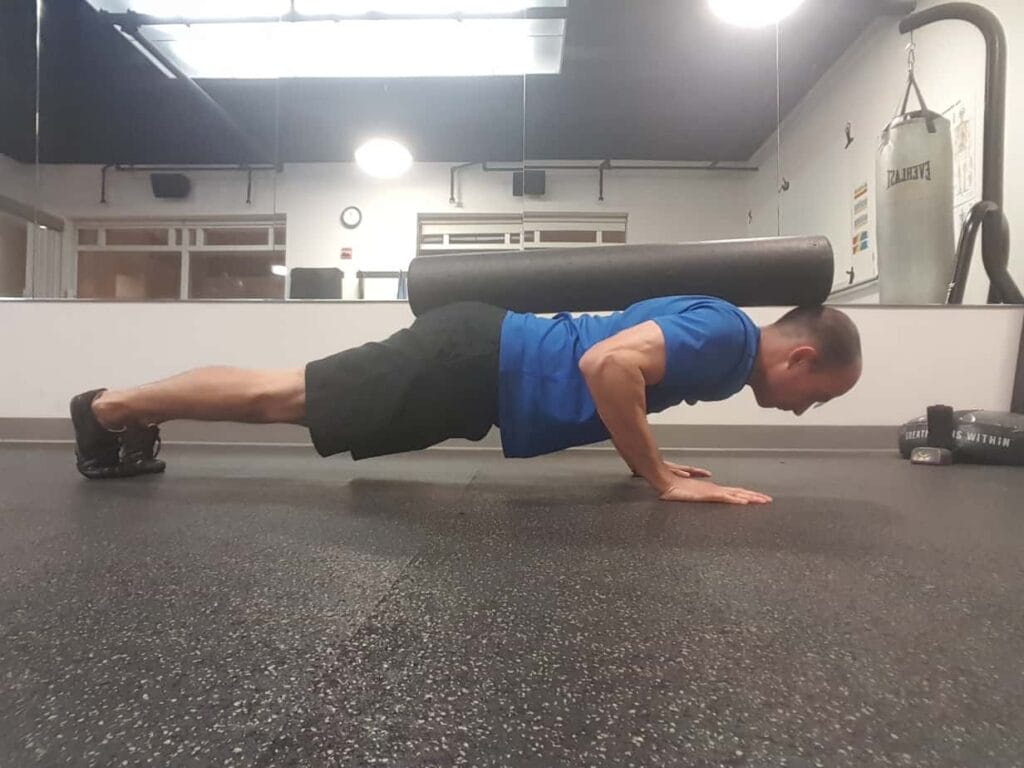Push-ups: So much more than just pushing up
When it comes to “the basics”, push-ups are often underestimated and undervalued. In addition to building ‘pushing’ strength, they represent an opportunity to develop a number of additional qualities at the same time, making them an exercise packed with nutritional goodness.
There are, however, some push-up ‘trouble spots’ that I see fairly often—particularly with circus folkx—so I thought I should take some time to address them.
Let’s start with the foundation.
Because, well, it’s what everything gets built on.
The foundation of the push up is the same as the body position for a plank.
Because I don’t want to assume, we should take a moment to make sure we’re on the same page with respect to what that looks like.

Strong neutral.
It should be like your regular standing posture: neutral thoracic spine, neutral pelvic tilt.
Neutral, but strong: Strong neutral.
From here, before you even move, you get to work on
- scapular stability—since you’re actively preventing your torso from drooping down between your shoulder blades;
- core engagement—an isometric co-contraction of muscles such as the transverse abdominus, internal and external obliques and your rectus abdominus;
- core control—in this case, by resisting extension of your low back to maintain your neutral spinal position;
- glute engagement from a neutral pelvic position—because of course you’re squeezing your glutes;
- leg intention—because your legs aren’t just straight, they’re intentionally straight; and
- adductor engagement—because you’re not just keeping your legs straight, you’re also squeezing them together.
See? Packed with nutritional goodness.
And this brings us to potentially contentious opinion #1:
For those who are building up to full push-ups on the ground, steer clear of the bent-knee version.

Why?
In general, what makes the bent-knee push-up not my favorite choice is this: many of the people we train have tight hip flexors—specifically, rectus femoris. Since rectus femoris crosses two joints (the hip and the knee), if it’s tight and you bend your knees, it pulls your hip into slight flexion and can sometimes result in a butt-in-the-air push-up.

And as soon as your hip flexes a little, your glutes disengage a little. When that happens, push-ups tend to get harder. (And you miss out on the opportunity to generate whole-body tension with your glutes!)

As an experiment, if you’re not already in the habit of squeezing your glutes when you do push-ups, try it. If you are, try doing some push-ups without squeezing your glutes and see if you notice how much harder you have to work.
For clarity: I’m not saying to never do the bent-knee push-up. There are those who have sufficient body awareness and control (read: glute strength) to keep their hips in neutral with glutes and core tight…and if you can do that—and you don’t have any way of raising your hands/torso and progressively lowering it as you work towards a full push-up, then this is the way to go.
If, however, you can elevate your torso, then I say do it because it allows you to reap all of the benefits of holding a strong neutral body position while you work on building the upper body strength to do more push-ups.
As a general strategy, I would pick a height where you can do eight push-ups to start. A week or two later, aim for ten. Then twelve. Then move to a lower height and repeat the process.
Now then.
On the surface of it, this has just been a rather long-winded ‘exercise tip’: if you’re working on your push-ups, do the elevated version for more goodness.
But wait, there’s more!
This is just the beginning of an extended thought on push-ups that was born over the course of several evaluations with circus artist-athletes (and it’s been stewing in my brain for a while now) …so I’m going to have to break this up over more than one post.
Until next time…
And this is, of course, just one piece of the larger puzzle that is your whole-body strength and conditioning plan. Circus arts require a foundation of whole-body, general strength upon which to build the specific-strength needed for all of the cool tricks and skills you want to do.
Need some help figuring out just what to do? Drop me a line. (Do people even say that anymore? Am I dating myself?) I’d be more than happy to help you with some ideas.Or maybe you’d like me to do the thinking for you so that you can just get down to the business of getting stronger…well, we have things for that, too.

